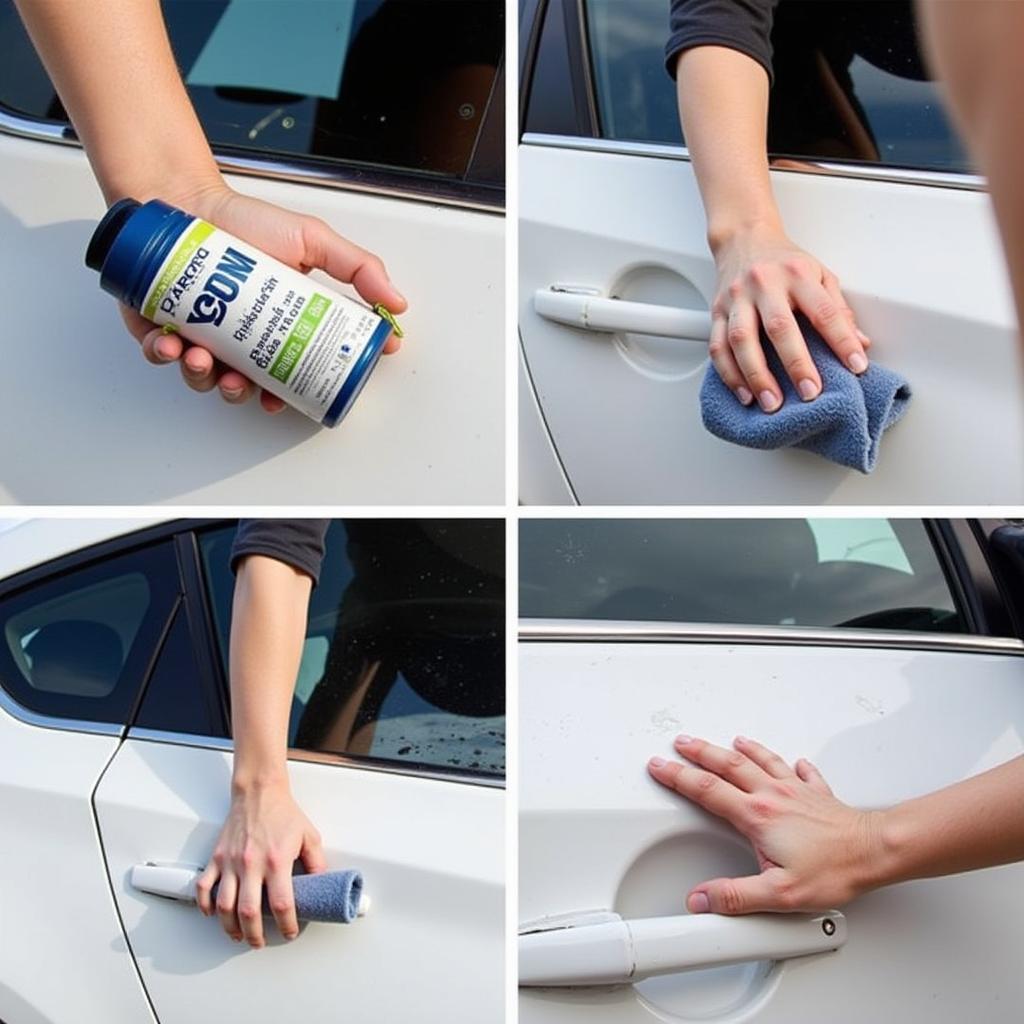A leaky valve stem can be a real pain, slowly deflating your tire and leaving you stranded. Knowing how to fix a leaky valve stem on your car tire is a valuable skill that can save you time, money, and a lot of hassle. This guide will walk you through the process, from diagnosis to repair, empowering you to handle this common car issue with confidence.
Identifying a Leaky Valve Stem
Before you start any repairs, it’s crucial to confirm that the valve stem is indeed the source of the leak. A simple way to check is by applying soapy water to the valve stem. If you see bubbles forming, you’ve found your culprit. Other signs include a slow leak that requires frequent tire inflation or a hissing sound coming from the valve area. Don’t ignore these signs; a seemingly small leak can lead to a flat tire and potentially dangerous driving conditions.
Sometimes, the problem isn’t the valve stem itself, but the valve core inside. fix leaking car tire valve provides more insights on addressing valve core leaks specifically.
Gathering Your Tools and Materials
Fixing a leaky valve stem is a surprisingly simple task that requires only a few basic tools. You’ll need a valve core tool (easily found at auto parts stores), a new valve core (also readily available), and an air compressor. Having a tire pressure gauge on hand is also helpful for checking your tire pressure after the repair. These inexpensive tools are a great investment for any car owner.
How to Fix the Leaky Valve Stem: A Step-by-Step Guide
- Deflate the tire: Completely deflate the tire by pressing down on the valve core pin with the valve core tool or a small screwdriver. This releases the remaining air pressure and makes it safer to work on the valve.
- Remove the old valve core: Using the valve core tool, firmly grip the valve core and unscrew it counterclockwise. Be prepared for a small burst of air as the core is removed.
- Install the new valve core: Thread the new valve core into the valve stem, screwing it in clockwise until it’s snug. Don’t overtighten it, as this can damage the valve stem.
- Inflate the tire: Using an air compressor, inflate the tire to the recommended pressure listed on the tire sidewall or in your car’s owner’s manual.
- Check for leaks: Apply soapy water to the valve stem again. If no bubbles appear, you’ve successfully fixed the leak!
how to fix car tire valve offers additional visual guides and tips for this process. Also, understanding how to fix other common car issues, such as a hydraulic car jack (how to fix a hydraulic car jack), can be equally beneficial.
Preventing Future Valve Stem Leaks
While fixing a leaky valve stem is straightforward, prevention is always better than cure. Regularly checking your tire pressure and inspecting your valve stems for signs of wear and tear can help prevent future leaks. Consider using valve caps to protect the valve stems from dirt and debris. These simple steps can save you from the inconvenience and potential danger of a flat tire.
“A little preventative maintenance goes a long way,” says Robert Johnson, a seasoned automotive technician with over 20 years of experience. “Regularly checking your tire pressure and inspecting your valve stems can save you from headaches down the road.”
Conclusion
Learning how to fix a leaky valve stem on a car tire is a simple yet essential skill for every car owner. By following these easy steps, you can quickly address this common problem, saving yourself time and money. Remember to always prioritize safety and consult a professional if you’re unsure about any aspect of the repair process. For further assistance or expert advice on car maintenance and repairs, don’t hesitate to contact AutoTipPro at +1 (641) 206-8880 or visit our office at 500 N St Mary’s St, San Antonio, TX 78205, United States.
“Knowing how to handle minor car repairs like this empowers you and gives you peace of mind on the road,” adds Johnson.
FAQ
- How much does a new valve core cost? Valve cores are very inexpensive, typically costing just a few dollars.
- Can I drive with a leaky valve stem? It’s not recommended to drive with a leaky valve stem as it can lead to a flat tire and create a dangerous driving situation.
- How often should I check my tire pressure? It’s a good practice to check your tire pressure at least once a month.
- What if the leak persists after replacing the valve core? If the leak persists, the valve stem itself might be damaged and needs replacement. You can refer to resources like how to fix car tyre valve for further guidance.
- What are the signs of a worn-out valve stem? Cracks, dry rot, or visible damage are signs of a worn-out valve stem.
- Can I fix a leaky valve stem myself or should I go to a mechanic? Replacing a valve core is a simple DIY task, but if you are uncomfortable doing it yourself, a mechanic can quickly and easily fix it for you.
- My car won’t idle right after fixing a sensor, could a tire valve leak cause this? While unlikely, a significant tire pressure issue can indirectly affect other systems. Check out car won’t idle right after fixing map sensor for troubleshooting unrelated idle problems.





Leave a Reply